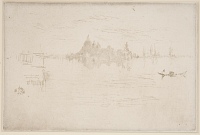Etchings Institutions search term: grolier club
Nocturne: Salute | ||
| Number: | 203 | |
| Date: | 1879/1880 | |
| Medium: | etching and drypoint | |
| Size: | 155 x 230 mm | |
| Signed: | butterfly at lower left (3-final) | |
| Inscribed: | no | |
| Set/Publication: | no | |
| No. of States: | 10 | |
| Known impressions: | 14 | |
| Catalogues: | K.226; M.223; W.199 | |
| Impressions taken from this plate (14) | ||
TECHNIQUE
The only known impression of the first state of Nocturne: Salute has not been located, and it is difficult to be certain about its technique from the collotype illustration reproduced by Kennedy, which also has been used for the first state illustration in this catalogue. 8 However, it appears that the copper plate was begun in pure etching, with alterations to the domes and façade of the church and the reflections made in drypoint as work on the plate progressed.
8: Kennedy 1910 (cat. no. 226 I).
Examination of the cancelled copper plate reveals that the etched lines, apart from a few horizontals and those depicting the gondola, are dotted and broken. This was probably intentional, to give a sense of buildings dissolving in evening mist. The broken lines found on the plate for Nocturne: Salute are carefully drawn and effectively etched into the copper, unlike underbitten lines found on some later Amsterdam plates (see, for example Little Nocturne, Amsterdam
[456]).
PRINTING
Whistler relied heavily on inking when printing most impressions of this print. In addition to using plate tone to produce nocturnal effects on sky and water, he often carefully wiped ink from the lights in front of Santa Maria della Salute, creating a series of glowing lamps between the church and the Dogana to its right.
The earliest proofs of the first and second states, printed in 1880 or 1881, are in black ink with little tone ( ,
,  ). The latter is on ivory laid paper with a partial watermark, the top of a shield and a plumed helmet (
). The latter is on ivory laid paper with a partial watermark, the top of a shield and a plumed helmet ( ). Whistler appears to have aimed at a variety of effects, with different colours of ink and shades of paper, printing only one or two impressions of each state.
). Whistler appears to have aimed at a variety of effects, with different colours of ink and shades of paper, printing only one or two impressions of each state.
Two impressions - of the fourth and eighth state - are in dark brown ink on ivory laid paper with a crowned 'GR' watermark ( ,
,  ). There are single proofs of the sixth and seventh states, the sixth printed in dark brown ink on ivory paper (
). There are single proofs of the sixth and seventh states, the sixth printed in dark brown ink on ivory paper ( ) and the seventh in black on off-white laid paper (
) and the seventh in black on off-white laid paper ( ). Other impressions, dating probably from 1885/1886, are mainly on laid papers including black ink on off-white (
). Other impressions, dating probably from 1885/1886, are mainly on laid papers including black ink on off-white ( ), and brown or dark brown ink on ivory (
), and brown or dark brown ink on ivory ( ,
,  ); and cream 'antique' (pre-1800) laid (
); and cream 'antique' (pre-1800) laid ( ). An impression of the final, tenth, state was kept by Whistler; it was printed in dark brown ink on ivory laid paper (
). An impression of the final, tenth, state was kept by Whistler; it was printed in dark brown ink on ivory laid paper ( ).
).
 ,
,  ). The latter is on ivory laid paper with a partial watermark, the top of a shield and a plumed helmet (
). The latter is on ivory laid paper with a partial watermark, the top of a shield and a plumed helmet ( ). Whistler appears to have aimed at a variety of effects, with different colours of ink and shades of paper, printing only one or two impressions of each state.
). Whistler appears to have aimed at a variety of effects, with different colours of ink and shades of paper, printing only one or two impressions of each state. Two impressions - of the fourth and eighth state - are in dark brown ink on ivory laid paper with a crowned 'GR' watermark (
 ,
,  ). There are single proofs of the sixth and seventh states, the sixth printed in dark brown ink on ivory paper (
). There are single proofs of the sixth and seventh states, the sixth printed in dark brown ink on ivory paper ( ) and the seventh in black on off-white laid paper (
) and the seventh in black on off-white laid paper ( ). Other impressions, dating probably from 1885/1886, are mainly on laid papers including black ink on off-white (
). Other impressions, dating probably from 1885/1886, are mainly on laid papers including black ink on off-white ( ), and brown or dark brown ink on ivory (
), and brown or dark brown ink on ivory ( ,
,  ); and cream 'antique' (pre-1800) laid (
); and cream 'antique' (pre-1800) laid ( ). An impression of the final, tenth, state was kept by Whistler; it was printed in dark brown ink on ivory laid paper (
). An impression of the final, tenth, state was kept by Whistler; it was printed in dark brown ink on ivory laid paper ( ).
).
